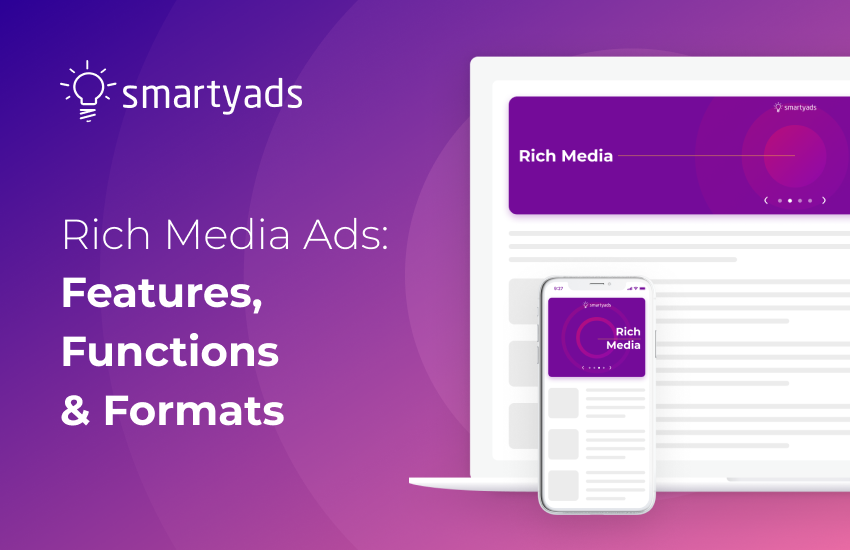As users are surrounded by more and more ads online, banner blindness becomes a real concern. However, rich media units more actively engage a web user than standard text ads. Engaging animation or other types of ads within this format look fresh to the users and fulfill advertising purposes.
“Rich media ad” is a term you’ve likely heard before — it’s one of the most innovative and popular types of display advertising. For several years, rich media assets displayed on the search network were the most popular form of advertising. But how are rich media ads different from other ad formats, what do they look like, and how do existing rich media assets help you meet your goals? Here is the ultimate guide to rich media ads and their benefits.

What are rich media ads?
What’s the explanation rich media ads have? The name says for itself — rich media ads include dynamic and interactive types of content like text, images, video, audio, games, animation or other types in various combinations. They have designs you can easily call “eye-catching”. Advertisers can easily create these types of ads, however, they will require a bit more time spent on designing than common static banners.
This way there’s a clear explanation rich media ads have - they are “rich” because they also include media. Among other formats rich media ads are the most varied ones. With this type of advertising, marketers can give customers new ways to engage with the product, service, or brand. So, how are rich media ads different from other ad formats? In order to understand it, let’s review their 5 common types.
5 most popular rich media ad formats
Compared to the traditional text or display formats of banner ads, rich media ads include multiple types. Such rich media ad formats can engage a web user more effectively than classic static image ads. They are displayed on the search network for millions of users every day and they are the top ones to consider, so, let’s review the most popular ads with animation. First, let’s take a look at banner ads rich media units.
Banners
These are more than just standard text or display banners. A rich media banner is a type of text ad that offers more interactivity and visual appeal than a standard banner. Banner ads rich media units include animation or other types of media. They can mix text and animated content and designs that react to user actions. Such an ad unit is usually located on top of the page for better visibility and offers wide opportunities for customization and use of different types of motion media.
- Loads quickly
- Can fit a lot of text
- High CTR
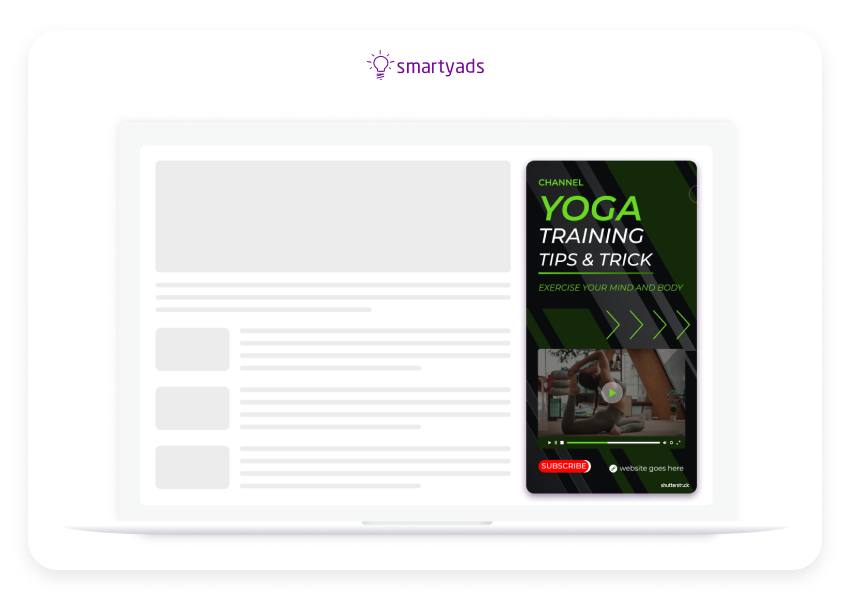
Interstitial ads
These ads can include animation or other types of motion, also they can include video ads flash elements. Interstitial ads take over the whole display size during transition points on websites or breaks in games. They can have a static location or move along as the user scrolls the page. Interstitial media ads include video. Also, these can be flash animated ads, type of text ad, or audio.
- High visibility
- Better engagement
- Impactful ad resolutions
Here is an example of an interstitial video.
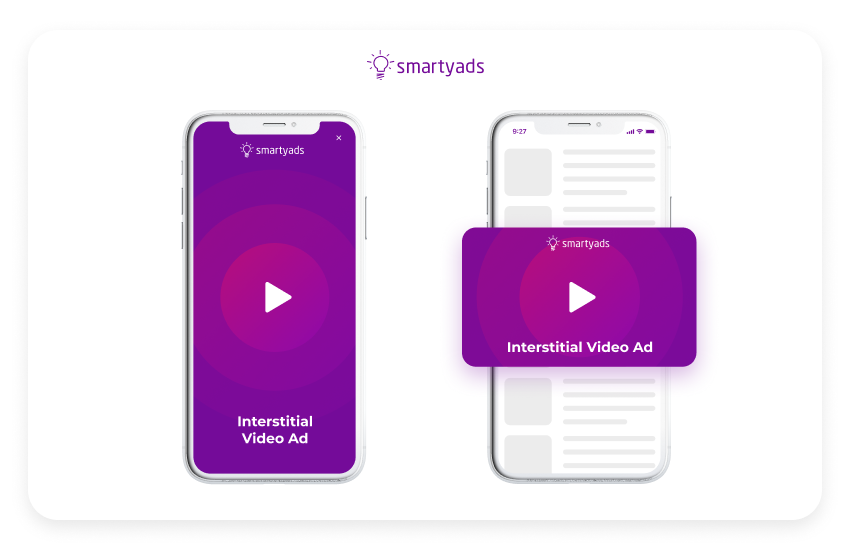
Pushdown ads
Pushdown ads appear as a small or medium-sized banner teaser. If the ad attracts the attention of the user, they can hover the cursor over the image or click on it to see it in full. The content of the page ad is located on will be pushed down, hence the name. Pushdowns can include animation or other types of interactive elements but unlike expandable ads, pushdown ads don't expand in size, it only pushes down the content of a webpage. The major benefit is that it doesn't overlap the webpage content.
- Does not disrupt the user experience
- Multiple interactions supported
- Fast loading time
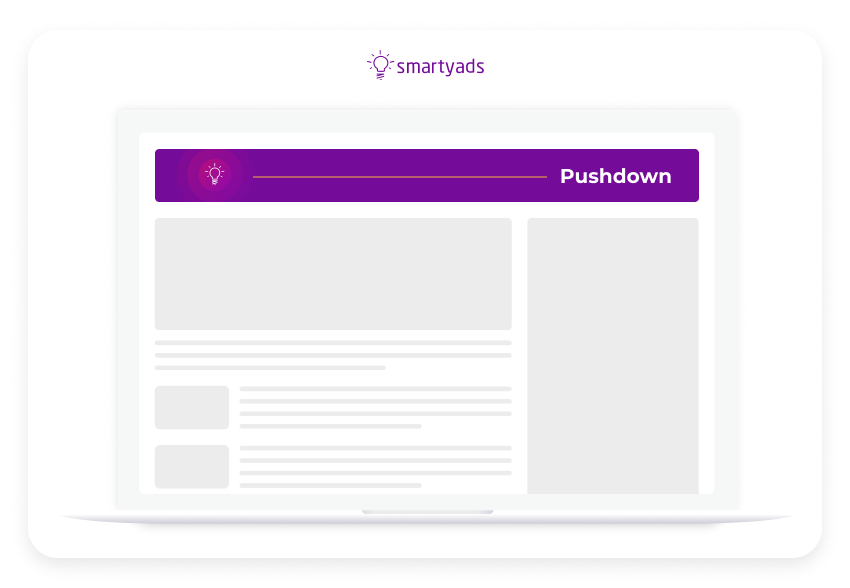
Expandable banner ads
Compared to regular banner ads, a rich media banner delivers better user engagement, they also include animation, video, or other types of motion. They can also mix text and animated content and designs that are responsive to user actions. It expands once the user performs a specific action, such as click, tap, or hover over the ad. Expandable banner ads come with a timer and go back to their original size once the time is out.
- Multiple interactions supported
- Faster loading
- High user engagement
There are also multi-directional expandable ads. This type of rich media ad will expand in multiple directions depending on where the ad is placed on the page. If the ad is located on the left of the webpage, it will expand to the right, and vice versa.
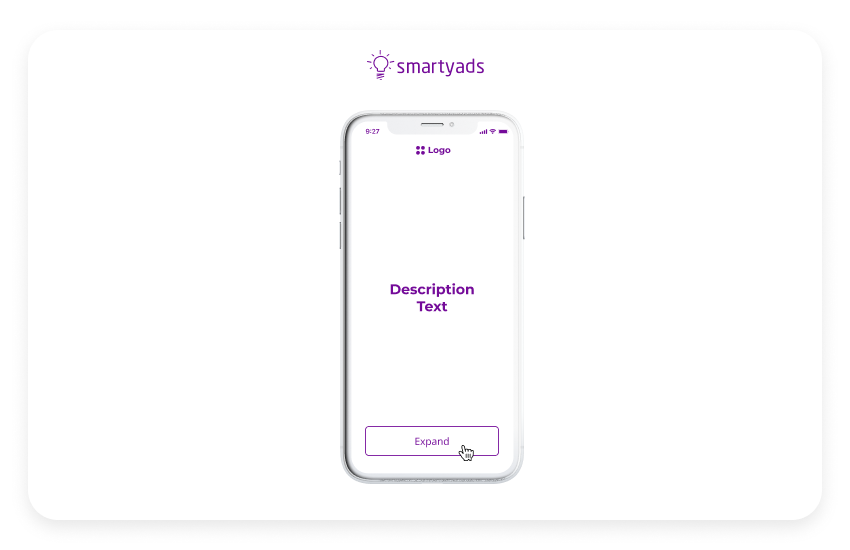
Slider ads
Slider rich media ads are placed on one side of the display — typically, the bottom right corner. They may include animation or other types of motion. As the user scrolls the page, the ad moves along with the text, and when the scrolling stops, the ad settles in its usual position. Animation or other types of media can be used here. Slider ads have designs you can easily adjust to complement user screens.
- Non-disrupting
- High CTR
- Better engagement
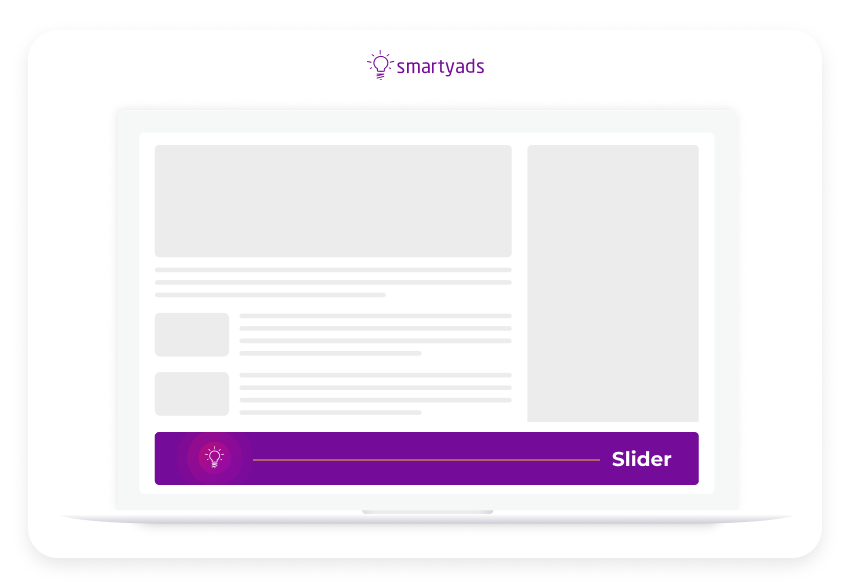
Rich media ad statistics: what the market looks like in 2021
A rich media ad is not exactly a brand new invention and has been around for years now. However, it has shown particular growth in the past few years. Every year, the spending on rich media continues to increase with a projected 2021 growth of 25.8% compared to 2020. Given the versatility and efficiency of rich media ads, the numbers will look even more impressive in the coming years. Why? Because more and more advertisers use existing rich media types of ads and the new are yet to be invented.
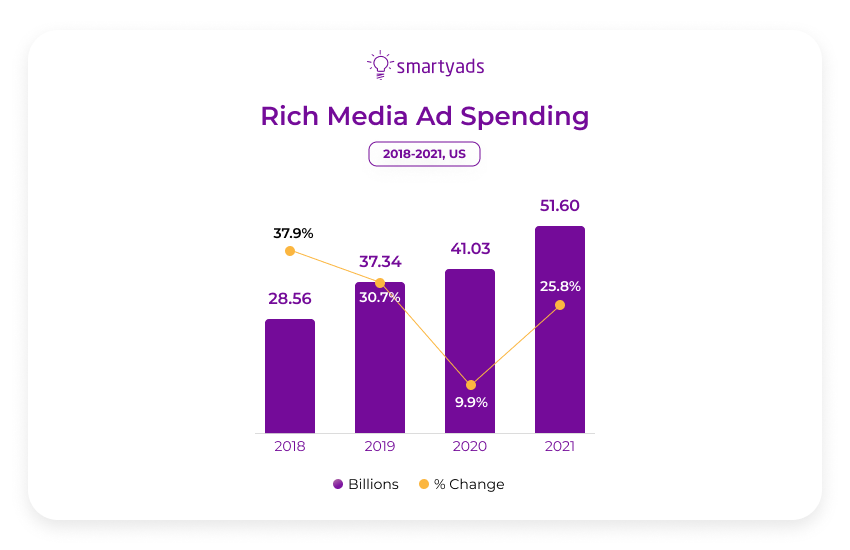
Rich media ads vs. standard display banners
Rich media and banner ads are both types of ads using which you can achieve more creativity. Plus, banners have been around forever and we are all used to those text or display ads. Rich media, on the other hand, is a relatively new concept for many advertisers. This is why the comparisons between the two formats are inevitable. So how are rich media ads different from other ad formats? Let's compare rich media ads to standard display banner units:
The main differences between banner ads and rich media ad formats.
| Feature | Standard text or display | Rich media ads |
| Interactivity | little to no interactivity | Ads with animation or ads that mix text with interactive elements. Often those are video ads flash animated. Rich media ads include video playback, unmuting the sound, and other interaction opportunities |
| Format | Image formats (.jpg, .png, .gif) + text | Image formats, HTML, video and audio |
| File size | 200Kb or less | 200 Kb or more |
| User experience | Many accidental clicks | Clicks are intentional and therefore organic |
| Video | Not supported | Widely used |
| Tracking | Just one click-through link | Multiple click-through links |
| Technology | No additional technologies | Java and Javascript |
| Additional features | None | Polite loading, mini-games, polls |
| CTR | 0.32% | 1.12% |
Benefits of rich media ads
For advertisers
Ads that mix text with animation can be very advantageous. A rich media ad is substantially different from other ad formats, so if you are now considering giving this format a try, here are the 5 biggest benefits of rich media for you as an advertiser:
- Higher efficiency. Rich media consistently displays higher CTR, which, in turn, leads to more conversions. In other words, more users will not only see your ad but also perform the desired actions.
- Better UI. Since rich media ads provide more opportunities for user interaction, are less disruptive than traditional banner ads, and are more visually appealing than banners, users tend to be more satisfied with their experience.
- Brand awareness. Rich media ads allow you to express your brand identity more effectively and keep the style consistent alongside different formats and platforms. Therefore, your brand awareness grows naturally.
- Detailed analytics. Banner ads have limited measurability: in most cases, the reports only include the impressions and the click-through rate. With rich media, you get to see the different ways in which the user interacts with your ad.
- Easy scalability. Rich media is a diverse format that can be used for a variety of purposes and in a variety of campaigns. You can easily design a campaign that fits your budget, brand, and purposes.
For publishers
It’s clear that rich media ads allow advertisers to reap the rewards of this innovative format, but what about the publishers? Explanation: rich media ads can also be very beneficial for you as a publisher, and here are a few advantages to prove it.
- User retention. Rich media ads don’t interrupt the browsing experience for the user, and even when the user interacts with a rich media ad, they are not forced to leave the publisher’s website right away.
- Higher revenue. Compared to standard banner units, rich media has a higher CPM - because they include animation or other types of media they are more engaging. Opting for rich media rather than regular banners allows you to make more money with nearly the same amount of work.
- Measurability. Just like advertisers using the rich media ad format, you get to see what works and what doesn’t when monetizing with rich media campaigns. Ads with animation are very trackable. The detailed statistics allow you to see your efforts pay off.

Two placement types for rich media ads
Rich media ads different in their structure, that’s what we’ve already found out. When it comes to placement, there are 2 ways you can serve rich media ad units on the website - statically and dynamically. Rich media can be displayed on a search network in a Google Ads Ad gallery or a web page of a particular website.
- Static (permanent) location. In this case, the rich media assets served on a web page for a certain time (negotiated by publisher and advertiser). Such display formats rich media ads stay in place when the page is refreshed. This means that the same ad unit is shown to every visitor of the web page. In this case, the advertiser typically pays for the total time the ad is placed on the page. Static ad placement is organized through manual ad placement (when the advertiser finds a suitable publisher and negotiates ad placing conditions personally via e-mail, phone, etc).
- Dynamic location. When placed dynamically, display formats rich media ads change each time the page is refreshed (or automatically after a certain period of time). In this case, the payment is calculated based on the number of impressions served by the publisher, or the total number of user clicks. If you want to organize a dynamic location, know that ads can be served through a third party ad server or a modern ad tech platform that works according to the principles of programmatic advertising.
So which one is better?
Typically the user is most likely to click on an ad when they see it for the first or second time. On subsequent website visits, a person simply stops paying attention to the banner that has become familiar. Especially this is true to static image ads but types of ads using video or animation can also be affected by this. So-called ad fatigue may result in the lover CTR and user engagement.
Therefore, it is better to choose dynamic ad placement, with at least several advertisements being in constant rotation on the website. This way the users will see the new ad each time the same web page reloads. The eye will not be "blurred" and the user won’t be subconsciously avoiding the ad.
Dynamically ads can be served through a third party ad server, however, the majority of advertisers prefer programmatic platforms since their dashboards are much simpler and understandable even for people with no advertising/tech background. Let’s see how they work.
How to serve rich media programmatically?
Rich media can be different from other ad formats, however, with ad tech platform functionalities it is possible to serve smoothly even those that include complex video ads flash elements. To clearly understand the mechanics of dynamic ad placement, let’s take a look at the ad serving mechanism.
It seems complicated but we can chop it down into several core steps:
- The user visits the publisher’s website which automatically collects the cookie data about the user, their device type, OS, geolocation, etc. This data is then transferred to the SSP (supply-side platform designed to automate media-selling for publishes).
- SSP sends the request to the RTB auction. This request contains information about the placement and information about the user (that advertisers need for correct targeting).
- By that time advertisers have already configured ad campaigns on DSP (demand-side platforms designed to automate the media-buying process for advertisers). Campaign details include user characteristics, budget settings, frequency, etc).
- DSP evaluates requests from publishers and matches them with campaign criteria. If they match the criteria, DSP sends a response with a bid to an ad exchange. The ad exchange holds an auction and defines a winner (the highest bidder).
- After this ad network or publisher’s third party ad server read the command and organize ad serving for this particular user.
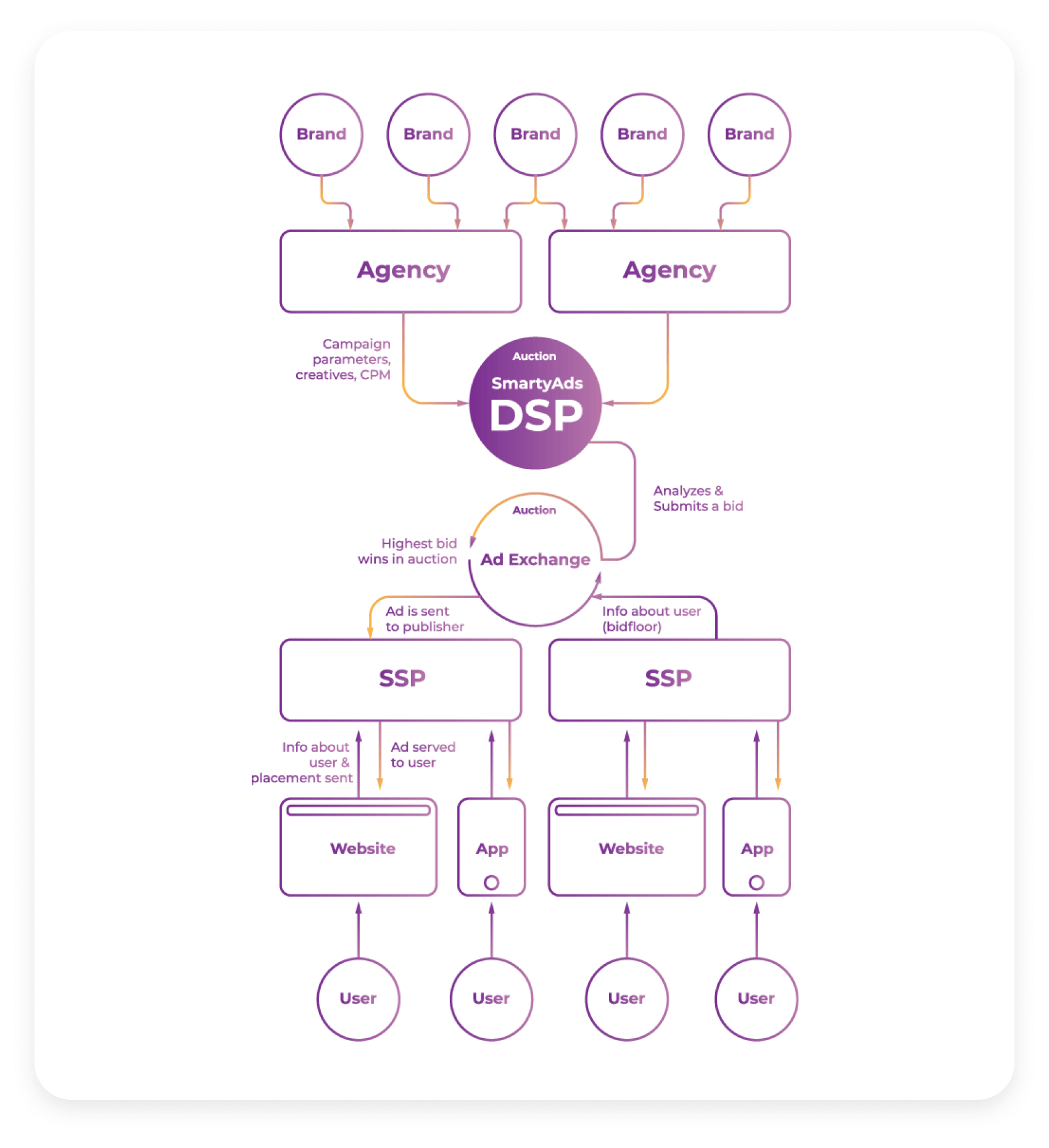
Why it’s good for advertisers. All that advertisers have to do is to log in on DSP, fill in the suitable budget, download and use existing rich media assets for one or several ad campaigns. The dashboard helps to configure the daily spend, frequency of impressions, and most importantly targeting (to show ads only to the right audiences). As for ad units, advertisers can determine in which formats they are displayed - one campaign can be video ads served on mobile for millennial audiences, the other one banner campaign for those users who use PCs. When choosing the formats they are displayed in, it is worth remembering that each unit should be suited to the environment it is served in - mobile, desktop, CTV). Professional designers can easily create these types of ads adjusting their resolutions to the right environments.
Why it’s good for publishers. Publishers can also serve display ads more effectively with SSP. They can register at the platform for free, set up their inventory slots, and configure the requirements for future ad campaigns. Although SSPs work automatically they bear no risk to the publishers. The placements will never be sold at a price that is disadvantageous to the publisher - before monetizing is started the publisher inputs a price floor below which the deals won’t happen. In the same way, publishers can set up what kind of rich media ads they allow to serve at their inventory, their resolutions, sizes, and other important details.
Final thoughts
Among other formats rich media ads stand out for a number of reasons. They can more actively engage a web user than standard text and static ad formats. They are very convenient and can be served on a search network or any webpage. Rich media ads offer a variety of solutions for advertisers who are no longer satisfied by the results of their banner ad campaigns. With animation or other types of motion in rich media ad units, advertisers can effectively appeal to their target audience while using their advertising budget more effectively. Ads with animation are very efficient but they also require you to constantly educate yourself and stay on top of the latest trends.
Now that you know the answer to the question: “How are rich media ads different from other ad formats?”, you are one step closer to launching your own impressive rich media ad gallery. On our demand-side platform, you will find all the tools and resources you need to meet your advertising goals.
Register on SmartyAds DSP and start serving impactful rich media campaigns!

